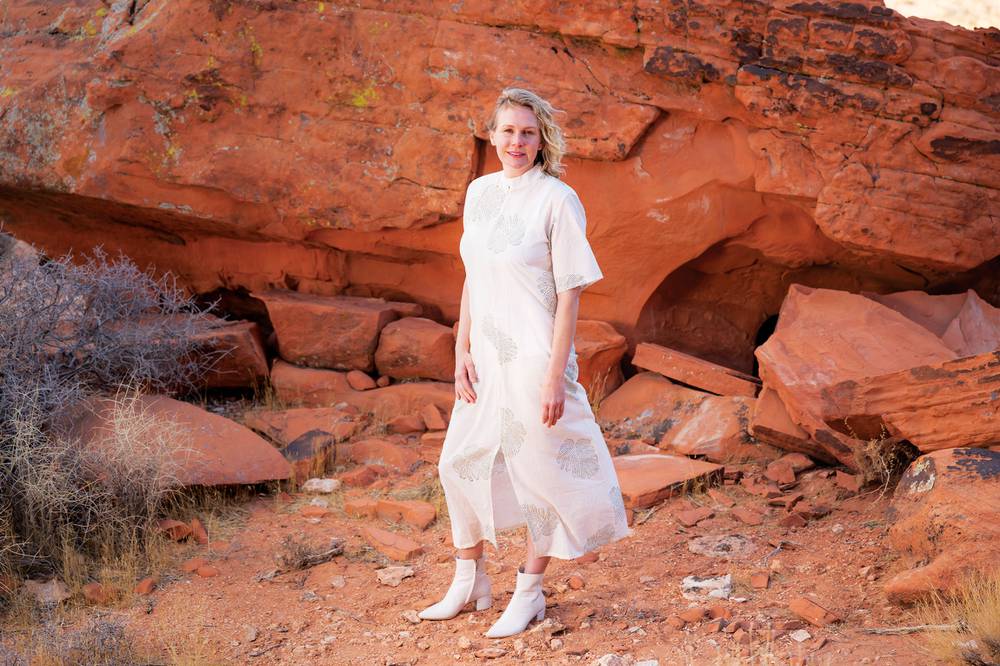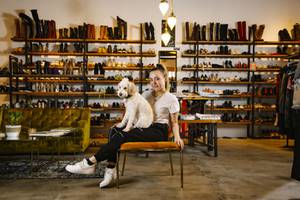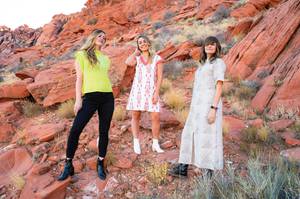From the deserts of Las Vegas and India to vintage 1960s fashion, clothing designer Megan Blattspieler draws inspiration from a variety of sources. She adds bright colors and a sense of fun to her styles, which you can find in her new sustainable women’s wear brand, Alissi (alissi.co). The Las Vegas-based Blattspieler teamed up with nonprofit group Saheli Women as her production partner, so that her designs are ethically made in North India.
Blattspieler spoke to Las Vegas Weekly about the need for sustainable fashion, the challenge of balancing motherhood with running a small business and her love of dresses that make folks happy.
Your professional background is in tech, fashion merchandising and marketing. How did you make the jump from the business side of fashion to the creative end? Being a lover of fashion and textiles, I’ve always done a little bit of sewing. My mom was a flight attendant for United Airlines, so I’ve done a lot of traveling. Every time I go somewhere, I go to the fabric store and pick up different fabrics. So [clothing design] is not something that’s been so far away from me. I’m just not ... classically trained.
How would you describe the look of an Alissi piece? My pieces are pretty simple. They’re meant to be easygoing, flattering, [with] feminine lines—lots of people can wear and find comfort in [them].
You take inspiration from ’60s fashions. What do you like about that era’s style? Just the simplicity. [It’s] still very feminine but sexy in different ways.
How do you develop your ideas? A lot of the designs come from vintage pieces. … You want to change it just a little bit to make it more modern for today. You’re like, “Oh, I wish this piece was just a little bit more like this.”
You’ve lived in Las Vegas for two years. Do you mine any artistic inspiration from the local area? Definitely. I did [a] photo shoot in Red Rock. Obviously, I got a plethora of inspiration from the colors and the rocks. Then, for every season, things change. Some of the shrubs have blues and purples in the winter. Then the lime-green lichen that just pops against all the red. ... I realized that it’s the same colors that I see in India, where I developed this whole first collection. It finally dawned on me that, oh, yeah, I was in the desert there and I’m in the desert here. So definitely, the desert terrain brings a lot of inspiration.
To whom do you see your brand appealing? Anybody who has an interest in sustainability, ethical fashion [and storytelling]. Each piece comes with a little tag of the woman who made it. It’s got this beautiful watercolor portrait and a little paragraph [about] who she is, a little bit of her story. I want every piece to be a treasure to people—something that they can put on when they’re having a bad day, which is also part of why the prints and colors are so vibrant and happy. It’s not really just a dress to put on to blend it. It’s like, you want to be noticed a little bit.
Where do you envision people wearing your clothes? Everywhere. Part of the story of this whole brand was: I had this one vintage dress that was my “put on and be happy” [dress]. If I didn’t want to do something or if I was having a bad day, I would wear it and it would make me smile. So I really envision [that for] these dresses. That’s part of why they’re comfortable and easygoing. Most of them have pockets. ... They’re meant to be practical, and they’re meant to be worn every day.
What are you working on now? A fall-winter line. There are some beautiful cashmere-blend fabrics that they’ve sourced, and then working on some new fabrics that are upcycled for jackets.
What should consumers know about sustainability in fashion? It is very hairy. It’s hard to truly be sustainable, because when you’re creating something new, that’s already not sustainable. However, using [natural] fibers and textiles that could eventually biodegrade and then natural dyes—these are much bigger pluses than just finding something that’s plastic … [that] will last forever and go to the landfill.
For people who aren’t in the fashion world, what’s the difference between fast and slow fashion? Slow fashion moves slower. It could take up to two months to get everything done, and that’s not even a huge order. It’s because the ladies take their time. They’re not worked to the bone. They’re not paid per piece. They’re given time and space to do their work. Whereas, fast fashion exploits workers, and usually it’s paid per piece.
Why are slow-fashion and sustainability particularly important now? It’s this double-sided problem with the fashion industry: It’s not just that we’re polluting the Earth with awful clothes made from polyester and rayon, but it’s also that the people making those clothes are treated horribly. And it’s also—maybe it’s three sided—this overwhelming need for consumerism.
Do you have any advice for people who want to participate in sustainable fashion but can’t afford expensive, new clothing?Secondhand fashion and thrifting is definitely making a huge wave in the fashion world. It’s great, because, whatever the saying is, one man’s trash is another man’s treasure.
How would you describe your personal style?I love prints and bright, colorful, whimsical things. I like to [be] fun and sophisticated at the same time.
Click HERE to subscribe for free to the Weekly Fix, the digital edition of Las Vegas Weekly! Stay up to date with the latest on Las Vegas concerts, shows, restaurants, bars and more, sent directly to your inbox!




